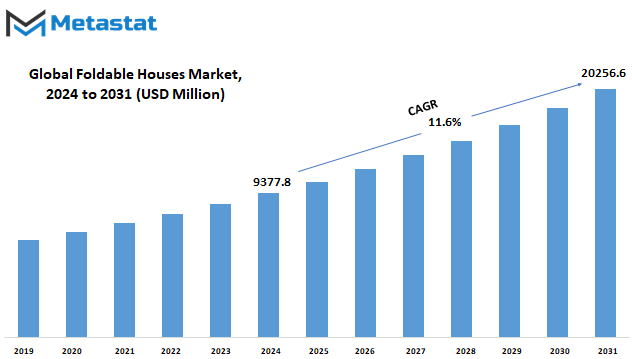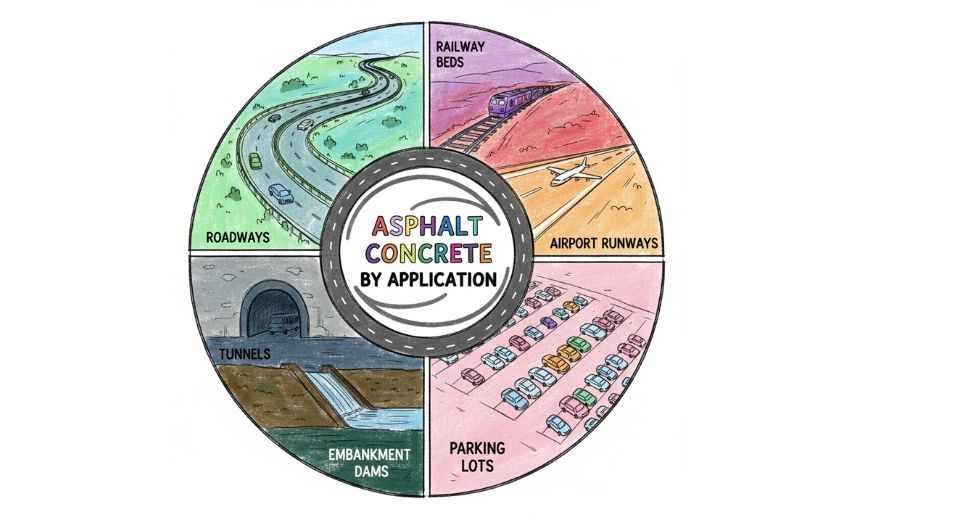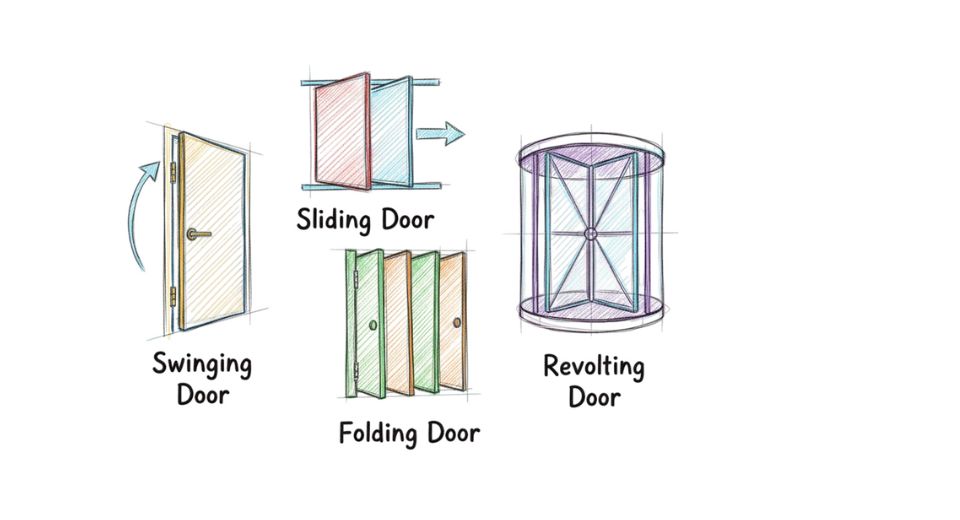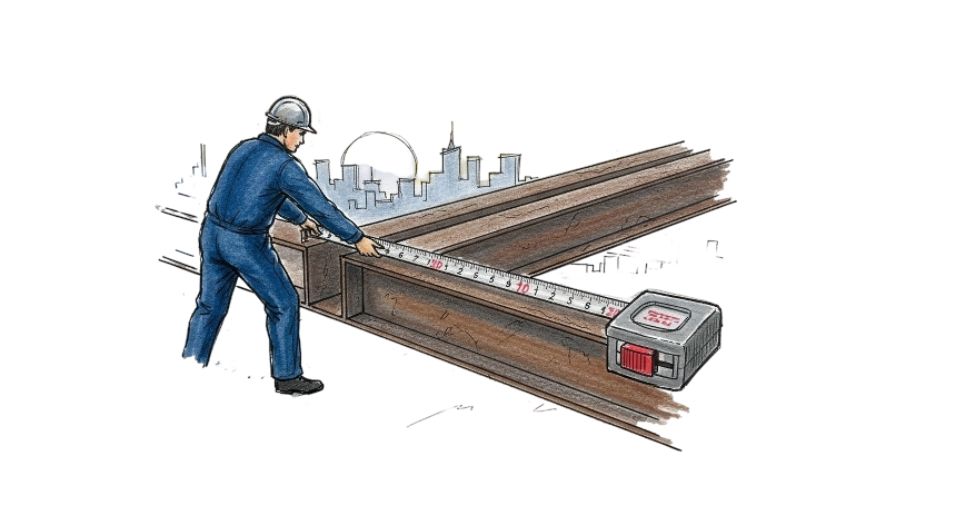MARKET OVERVIEW
As Global Foldable Houses market is getting popular in the housing and construction line, demand for foldable houses has increased due to the affordable and sustainable lifestyle solutions. Foldable houses sprouted as practical and innovative alternatives to conventional construction techniques, indicating the possibilities of versatile solutions to the growing need for flexible living spaces in the urban area. We are left with the scenario of foldable houses being an option in dealing with housing shortages, disaster relief, and the trend of minimalist and modular living as urbanization continues to get its head up in various cities around the globe.
Foldable houses have been designed focusing on flexibility and convenience. Unlike ordinary houses, they could be easily carried and assembled within a different environment, thus making them perfect for use in emergency settings or remote locations as well as temporary housing. This has attracted huge attention from governments, NGOs, as well as other private organization bodies seeking speedy turn-around housing solutions for housing emergencies, be it as a result of natural disasters or general housing crises. Furthermore, with an increased awareness of sustainability, folding houses can now claim the additional benefit of being “green,” often employing renewable materials and energy saving systems during their construction.
The Global Foldable Houses market will witness steady growth in the near future. There is a growing awareness of this specific housing model, which encompasses its promising advantages among people. Consumers, especially in urban centers, prefer affordable and compact housing options. Foldable houses can save time and money while reducing the ecological impact of construction. Along with all these improvements in construction technology and design, foldable houses will be even more attractive and functional in some cases, with better configurations and customizations.
Global Foldable Houses market is developing on a particular scale with the involvement of major players. Manufacturers, architects, and construction companies will unite to make something more specialized and efficient solutions for foldable housing. Future studies and innovations should likely involve enhancing the toughness, energy performance, and ease of construction of these houses. This will not only serve the needs of the consumers but also conform to regulatory standards. As technology continues to advance further, foldable houses can provide superior conditions of comfort and personalization that might be exploited by homeowners in mainstream houses, regardless of geographical location.
Further, the rise in demand for foldable houses is anticipated to be spearheaded by broader housing affordability and a concern for the environment. The Global Foldable Houses market will define the future of construction in accordance with its development concerning increasing consumers seeking cheaper sustainable housing. Regions having high population growth or experiencing a shortage in housing are also anticipated to increase foldable housing solutions that would lead to the expansion of the market.
In a nutshell, therefore, the Global Foldable Houses market encapsulates the challenging, growing, and dynamic sector of the construction industry, thus providing innovative solutions to the contemporary issues of housing. With such attractiveness in flexibility, sustainability, and cost-effectiveness, foldable houses are likely to remain prominent as an alternative to traditional models of housing. Huge growth and potential in supporting the housing needs of people from diverse backgrounds make the market a highly interesting arena for consumers as well as industry stakeholders in the coming years.
Global Foldable Houses market is estimated to reach $20256.6 Million by 2031; growing at a CAGR of 11.6% from 2024 to 2031.

GROWTH FACTORS
Several factors in the forthcoming years are expected to propel the increase in growth in the Global Foldable Houses market. Need for cheap and sustainable housing is one of the major factors behind this growth trend. As the world population keeps on increasing along with urbanization, people are in need of houses that could be easily and rapidly assembled. Foldable houses show flexibility in solving this problem, bringing affordability along with environmental impacts since most are designed and built using eco-friendly materials and energy-efficient system setups.
Technology is the other critical factor fueling the growth of Global Foldable Houses market. With evolving construction techniques, materials, and design, it is now feasible to imagine homes that will be durable as well as portable. Such a scope of convenience would attract a large line of buyers who are targeting some sort of temporary abode, mobile home, or any relief system during natural disasters. These technological advancements are likely to push this market ahead. Companies can open up lines of business in the production of better, more elaborate designs of these homes.
However, there are some points of potential constraining factors affecting the growth of the foldable houses market. The very first thing in this list is initial cost of production. Though these homes are lower to produce and maintain in the long run, the initial development cost of folding up housing units might be relatively so high to dissuade buyers. In addition to these market dynamics, regulatory issues also pose a threat to the growth of the market. Building and zoning regulations vary significantly between regions and countries. These may limit the demand for foldable houses in certain regions, thus preventing a full utilization of market potential.
However, opportunities abound for the Global Foldable Houses market in the near future. The rising interest in sustainability and affordable housing by governments as well as organizations around the world is expected to boost demand for foldable houses in the near future. Furthermore, the increasing natural disasters might create higher demands for easy and portable housing solutions that can be quickly deployed during a disaster. The market promises to be quite promising with prospects for future growth in that companies that will invest in developing foldable houses with improved features and affordability will set up themselves for a very strong position to take advantage of these trends in years to come.
MARKET SEGMENTATION
By House Type
Improvements in construction technology have created ample grounds for growth in the Global Foldable Houses market during the next few years. There has been a growing demand for affordable and more sustainable housing options. Foldable houses are transportable, easy to assemble, and provide unique solutions to the shortages of homes and the rising costs of traditional homes. If the urban population continues to grow, then there is likely to be increasing interest in foldable houses as a flexible space-efficient living option.
The foldable homes market may be divided into the type of houses, viz. Modular Foldable Houses, Collapsible Foldable Houses, Container-Based Foldable Houses, and Portable Tiny Foldable Houses, each with its benefits depending upon the need and choice. Modular foldable houses pre-fabricate the sections of the house off-site, which then get assembled at the site. This method saves time for construction, causes waste to be reduced, and therefore, is an attractive option for the ecologically conscious buyer.
Meanwhile, collapsible foldable houses are even more versatile. They can actually be folded into flat form for easy transportation to remote or hard-to-access areas, making them very appropriate in disaster relief transitional housing or simply in very remote infrastructure areas. With the seeming uncertainty that surrounds natural disasters and humanitarian crises in the future, it can be surmised that the demand for housing solutions like these will be in high demand.
Container foldable houses is a novel concept-reusing shipping containers as habitations. As there are quite a few shipping containers used in today’s world, living in the house made out of these is not just an affordable option but also exceptionally durable since the integrity of a shipping container is an important structural consideration. Reusing shipping containers for housing purposes will be an increasing trend because of growing concerns about sustainability. The design of the folded house out of containers is robust enough to be used in any kind of environment—be it urban or rural. Thus, they are a cheap means for those seeking long-lasting homes as well as durable housing.
Finally, portable miniature foldable houses enjoy increased interest because of the growing interest in the minimalist lifestyle. Portable portable tiny foldable houses provide compact, mobile homes which can be moved and set up conveniently, appealing to those who must be mobile and yet require comfort without sacrifice. As growing numbers of people choose alternative environments for living towards achieving sustainability and flexibility, the demand for portable foldable tiny houses promises to expand enormously.
Future trends in technology will further influence consumer preferences towards environmentally friendly, cost-competitive housing, and therefore, with Global Foldable Houses, people will get innovative solutions for housing requirements worldwide.

By Construction Type
The Global Foldable Houses market has every potential to be an optimal problem-solving solution for the future housing problem. With increasing populations and urbanization trends, affordable, space-saving, and sustainable options become critical. Foldable houses are meant to provide flexibility and convenience, especially in areas where traditional construction methods are expensive or slow. These houses can be erected within no time, and they are usually ideal for disaster relief purposes, military camps, or the most remote places in the globe. Foldable houses may also feature more frequently in the urban landscape as construction techniques progress to address the emerging needs of modern housing.
Foldable houses are divided based on the type of construction into two broad categories: Single Section and Multi-Section. Single-section foldable houses are small and easy to move. Therefore, it is very handy for a single person or a couple who might be living alone. However, this particular foldable house is very helpful where temporary emergency needs arise, especially in cases of a short stay at a given location, where access happens to be limited. Multi-section foldable houses are larger and hence more versatile. These can be expanded to build bigger liveable areas, making them adaptable enough for a longer housing space or perhaps even commercial use. Hordes of people may look for multi-section houses because they provide more space but retain the convenience of easy transportation and assembly.
The Global Foldable Houses market will have a great future in the future. The advancements in materials and construction techniques would ensure that the homes became durable, energy-efficient, and customizable. Since the concerns over environmental sustainability increase, foldable houses can help reduce carbon footprints associated with regular construction. Moreover, foldability and ease in assembly make foldable houses the smart choice for fragile disaster-prone areas or ones with little structural infrastructure.
More and more individuals and businesses will come to understand the market opportunity for foldable houses. Many governments and organizations around the world are beginning to realize the merits of investing in such innovative housing solutions, and they may lead to a spate of research and development. Foldable houses, though originally considered as a temporary solution, could very well be the permanent solution for the future of housing. Their flexibility, adaptability, and sustainability to meet the continuously increasing demand for affordable sheltering facilities will, therefore, determine the face of the future global housing market.
By Application
It is seen that foldable houses have growing interest in the global markets as an ideal alternative for a lot of applications in different industries. The demand for efficient space-saving housing has primarily been driving this trend. As a result of increasing urbanization and greater residential crowding, demand for adaptable housing has become critical. Foldable houses can proffer a futuristic solution by having a compact, mobile structure that can quickly be carried and assembled, making them suitable for areas with limited space or where housing is urgently needed.
Foldable houses may revolutionalize the building and provision of homes in residential use. These homes enable fast construction, thus avoiding the long wait times associated with a traditional way of building houses. Foldable homes can be an alternative practical means of owning a home with minimal costs in comparison to a traditional house, which usually would cost a family or individual lots of money to acquire. Foldable houses are also seen as environmentally friendly as most designs usually employ the use of eco-friendly materials and construction methods in its making.
Application of Foldable Houses: other than using it for residential purposes, foldable houses have significant uses for emergency and disaster relief situations. These can be easily deployed to offer temporary shelter to individuals and communities affected by such disasters as earthquakes and floods. The transportation and assembly ease of foldable houses offers a pragmatic solution for humanitarian aid organizations. As climate change continues to impact the frequency and severity of natural disasters, it may play a significant role globally in enhancing response to such events.
Foldable houses are also getting advantages in military and defense sectors, mainly through temporary shelters for personnel in areas that are remote or hostile. The structure’s portability allows military forces to be established and moved as and when required. Thus, military forces can always stay abreast of the changed circumstances within a flash of an eye. For that reason, these shelters are very durable and reliable and worth using in defense operations.
Foldable houses are also being used in the commercial sector increasingly for temporary workspaces, events, and pop-up shops. Their portability and ease of use are incredible advantages over other structures for business users needing short-term, adaptable space. As foldable houses use multiply across various applications into global markets, it will increasingly become part of everyday life and part of daily life.
|
Report Coverage |
Details |
|
Forecast Period |
2024-2031 |
|
Market Size in 2024 |
$9377.8 million |
|
Market Size by 2031 |
$20256.6 Million |
|
Growth Rate from 2024 to 2031 |
11.6% |
|
Base Year |
2022 |
|
Regions Covered |
North America, Europe, Asia-Pacific Green, South America, Middle East & Africa |
REGIONAL ANALYSIS
The Global Foldable Houses market is expected to see strong growth, as regional demand has started across different geographies. Geographical segmentation for this market includes North America, Europe, Asia-Pacific, South America, and Middle East & Africa. Opportunities and challenges in each geography shape the future of this market.
The North America foldable houses market would include both markets from the United States, Canada, and Mexico. With the recent increase in house shortages being experienced in U.S. cities and other parts of this region, demand in housing is expected to pick up. With the general rise in concern for living green, foldable houses could easily be in high demand as a practical solution for affordable homes that are not unfriendly to the environment. This would similarly apply in Canada and Mexico, as the two countries have different climatic and topographical conditions, where demand may become inevitable in regions where the more common solutions for housing cost too much or are impractical.
Europe, particularly with established infrastructure and focus on sustainability, could be another location where the foldable house market would thrive. The UK, Germany, France, and Italy could thus experience increasing demand as these countries try to bridge the housing gap in urban and rural locations, where there is now usually a need for both space and high cost in major cities. These structures are flexible and efficient, and governments and individuals find them attractive. In lands where availability is scarce and expensive, governments and people may like these structures.
Asia-Pacific region, which includes countries such as India, China, Japan, and South Korea, has also become an increasingly promising market for foldable houses. Countries like India and China face explosive urbanization and population growth, making the necessity for flexible and innovative housing solutions a top priority. With development, foldable houses might, at later stages, emerge as an efficient and cost-effective method of covering the housing needs of large populations within these countries. Given the prevalence of natural disasters in Japan and South Korea, such as earthquakes, foldable houses can offer safer, more adaptable housing solutions.
Brazil and Argentina are among the most important players in the foldable houses market of South America. For huge areas with rural economic imbalances, foldable houses might seem to be a viable housing stock for low-income populations. The same pattern will probably continue in the Middle East & Africa, mainly in GCC countries, Egypt, and South Africa as folding houses are adequate and inexpensive. The regions are characterized by a shortage of housing and economic problems which may make foldable houses an interesting solution. It will be interesting to see how the entire market dynamics changes as regional factors dictate how fast the Global Foldable Houses market would develop.
COMPETITIVE PLAYERS
The Global Foldable Houses market is robust; therefore, it remains stable and at the same time continues to attract attention by propelling innovation in housing solutions. The foldable houses provide an alternative way of constructing from the traditional methods in construction, offering a flexible, efficient, and easily portable and assembled living space. There is an increase in urbanization, and the demand for affordable and sustainable housing solutions keeps on growing; this market will be fulfilled with its demands on such a changing world.
Many companies have already capitalized on this market, with each bringing something diverse to the table in terms of strength and innovation. For example, ROKiT Homes is well-known for foldable house technology, which, as their product, is very affordable and very functional. Boxabl Inc., meanwhile, has been known to have great foldable home designs that can literally be set up in an hour or less. MADI Home and Ten Fold Engineering also play a significant role in the industry as they have exclusive designs and modular approaches to living.
Another company is Hebei Weizhengheng Modular House Technology Co., Ltd. Moreover, their competence in prefabricate manufacture contributes to the market. Another such smaller company is Little Giant Modular and Karmod Prefabricated Technologies. They are an attention-grabber in the industry due to the credence they place on sustainability and innovation. YG Engineering Machiner and SY & CO. International Trading Corps. continue to expand the reach of foldable houses all over the world through offering to much diverse housing needs in terms of adaptability and efficiency. Brette Haus SIA and CIMC TLC conclude this playing field with their compact and eco-friendly living arrangements in perfect fit for the broadest of markets.
The Global Foldable Houses market will, at some point in the future, continue to grow as the developing companies get enticed with research and technology investments to make foldable homes even more robust, affordable, and versatile. A pertinent market that offers immense innovation and growth potential is a market such as this, where pressure is created to develop sustainable living. Companies that successfully integrate eco-friendly materials and energy-efficient designs will likely lead the way in this market. With ever-increasing city dwellers, foldable houses might be the future way to address shortfalls in accommodation and will be made practicable over time. A battle among the players in this industry will bring more innovations that ensure foldable homes will continue to be on top of the world housing market.
Foldable Houses Market Key Segments:
By House Type
- Modular Foldable Houses
- Collapsible Foldable Houses
- Container-Based Foldable Houses
- Portable Tiny Foldable Houses
By Construction Type
- Single Section
- Multi-Section
By Application
- Residential Use
- Emergency and Disaster Relief
- Military and Defense
- Commercial Use
Key Global Foldable Houses Industry Players
- ROKiT Homes
- Boxabl Inc.
- MADI Home
- Ten Fold Engineering
- Hebei Weizhengheng Modular House Technology Co., Ltd.
- Little Giant Modular
- Karmod Prefabricated Technologies
- YG Engineering Machiner
- SY & CO. International Trading Corps.
- Brette Haus SIA
- CIMC TLC
WHAT REPORT PROVIDES
- Full in-depth analysis of the parent Industry
- Important changes in market and its dynamics
- Segmentation details of the market
- Former, on-going, and projected market analysis in terms of volume and value
- Assessment of niche industry developments
- Market share analysis
- Key strategies of major players
- Emerging segments and regional growth potential








 US: +1 3023308252
US: +1 3023308252






